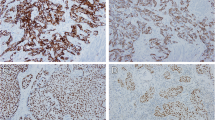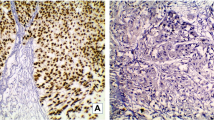Abstract
Bladder cancer tumors can be divided into two molecular subtypes referred to as luminal or basal. Each subtype may react differently to current chemotherapy or immunotherapy. Likewise, the technology required for comprehensive molecular analysis is expensive and not yet applicable for routine clinical diagnostics. Therefore, it has been suggested that the immunohistochemical expressions of only two markers, luminal (CK20+, CK5/6–) and basal (CK5/6+, CK20–), is sufficient to identify the molecular subtypes of bladder cancer. This would represent a molecular grade that could be used in daily practice. Molecular classification is done using immunohistochemistry to assess luminal-basal phenotype based on tissular expression of CK20 and CK5/6 as surrogate for luminal or basal subtypes, respectively. A series of 147 non-muscle-invasive bladder carcinoma cases was selected, and the tumors were divided into four subgroups based on the presence of CK20 and/or CK5/6, that is, null (CK20−, CK5/6−), mixed (CK20+, CK5/6+), basal (CK20−, CK5/6+), and luminal (CK20+, CK5/6−) categories. Survival analysis was estimated using the Kaplan-Meier method and the log-rank test. Hazard ratios were calculated by Cox multivariate analysis. The molecular grade included cases with null (n = 89), mixed (n = 6), basal (n = 20), and luminal (n = 32) phenotypes with differences in recurrence-free, progression-free and cancer-specific survival associated with molecular-grade categories in patients with low- or high-grade Ta, or high-grade T1 tumors. The multivariate analysis identified the luminal phenotype as a predictor of more aggressive neoplasms. Our findings provide a rationale to investigate luminal and basal subtypes of bladder cancer using two gene expression signatures as surrogate markers and show that non-muscle-invasive bladder carcinoma can be stratified into biologically and clinically different subgroups by using an immunohistochemical classifier.







Similar content being viewed by others
References
Holmäng S, Hedelin H, Anderström C, Holmberg E, Busch C, Johansson SL (1999) Recurrence and progression in low grade papillary urothelial tumors. J Urol 162:702–707
D’Andrea D, Abufaraj M, Susani M et al (2018) Accurate prediction of progression to muscle-invasive disease in patients with pT1G3 bladder cancer: a clinical decision-making tool. Urol Oncol Semin Orig Investig 36:239.e1–239.e7. https://doi.org/10.1016/j.urolonc.2018.01.018
Gontero P, Sylvester R, Pisano F, Joniau S, Vander Eeckt K, Serretta V, Larré S, di Stasi S, van Rhijn B, Witjes AJ, Grotenhuis AJ, Kiemeney LA, Colombo R, Briganti A, Babjuk M, Malmström PU, Oderda M, Irani J, Malats N, Baniel J, Mano R, Cai T, Cha EK, Ardelt P, Varkarakis J, Bartoletti R, Spahn M, Johansson R, Frea B, Soukup V, Xylinas E, Dalbagni G, Karnes RJ, Shariat SF, Palou J (2015) Prognostic factors and risk groups in T1G3 non-muscle-invasive bladder cancer patients initially treated with bacillus calmette-guérin: results of a retrospective multicenter study of 2451 patients. Eur Urol 67:74–82
Mulder AH, Van Hootegem JCSP, Sylvester R et al (1992) Prognostic factors in bladder carcinoma: histologic parameters and expression of a cell cycle related nuclear antigen (Ki67). J Pathol 166:37–43
Yan Y, Andriole GL, Humphrey PA, Kibel AS (2002) Patterns of multiple recurrences of superficial (Ta/T1) transitional cell carcinoma of bladder and effects of clinicopathologic and biochemical factors. Cancer. 95:1239–1246
Lopez-Beltran A, Montironi R (2004) Non-invasive urothelial neoplasms: according to the most recent WHO classification. Eur Urol 46:170–176
Lopez-Beltran A (2008) Bladder cancer: clinical and pathological profile. Scand J Urol Nephrol 42(s218):95–109
Babjuk M, Böhle A, Burger M et al (2016) EAU guidelines on non–muscle-invasive urothelial carcinoma of the bladder: update. Eur Urol 71:447–461
Humphrey PA, Moch H, Cubilla AL, Ulbright TM, Reuter VE (2016) The 2016 WHO classification of tumours of the urinary system and male genital organs-part B: prostate and bladder tumours. Eur Urol 70:106–119
Cheng L, Zhang S, Davidson D, MacLennan G, Koch M, Montironi R, Lopez-Beltran A (2009) Molecular determinants of tumor recurrence in the urinary bladder. Future Oncol 5:843–857
Choi W, Ochoa A, McConkey DJ et al (2017) Genetic alterations in the molecular subtypes of bladder cancer: illustration in the cancer genome atlas dataset. Eur Urol 72:354–365
Volkmer JP, Sahoo D, Chin RK (2012) Three differentiation states risk-stratify bladder cancer into distinct subtypes. PNAS 109:2078–2083
Dadhania V, Zhang M, Zhang L, Bondaruk J, Majewski T, Siefker-Radtke A, Guo CC, Dinney C, Cogdell DE, Zhang S, Lee S, Lee JG, Weinstein JN, Baggerly K, McConkey D, Czerniak B (2016) Meta-analysis of the luminal and basal subtypes of bladder cancer and the identification of signature immunohistochemical markers for clinical use. EBioMedicine 12:105–117
Kamat AM, Hahn NM, Efstathiou JA, Lerner SP, Malmström PU, Choi W, Guo CC, Lotan Y, Kassouf W (2016) Bladder cancer. Lancet. 388(10061):2796–2810
McConkey DJ, Choi W, Ochoa A, Siefker-Radtke A, Czerniak B, Dinney CPN (2015) Therapeutic opportunities in the intrinsic subtypes of muscle-invasive bladder cancer. Hematol Oncol Clin North Am 29:377–394
Choi W, Czerniak B, Ochoa A, Su X, Siefker-Radtke A, Dinney C, McConkey DJ (2014) Intrinsic basal and luminal subtypes of muscle-invasive bladder cancer. Nat Rev Urol 11:400–410
Czerniak B, Dinney C, McConkey D (2016) Origins of bladder cancer. Annu Rev Pathol Mech Dis 11:149–174
Dyrskjot L, Zieger K, Real FX, Malats N, Carrato A, Hurst C, Kotwal S, Knowles M, Malmstrom PU, de la Torre M, Wester K, Allory Y, Vordos D, Caillault A, Radvanyi F, Hein AMK, Jensen JL, Jensen KME, Marcussen N, Orntoft TF (2007) Gene expression signatures predict outcome in non-muscle-invasive bladder carcinoma: a multicenter validation study. Clin Cancer Res 13:3545–3551
Hedegaard J, Lamy P, Nordentoft I, Algaba F, Høyer S, Ulhøi BP, Vang S, Reinert T, Hermann GG, Mogensen K, Thomsen MBH, Nielsen MM, Marquez M, Segersten U, Aine M, Höglund M, Birkenkamp-Demtröder K, Fristrup N, Borre M, Hartmann A, Stöhr R, Wach S, Keck B, Seitz AK, Nawroth R, Maurer T, Tulic C, Simic T, Junker K, Horstmann M, Harving N, Petersen AC, Calle ML, Steyerberg EW, Beukers W, van Kessel KEM, Jensen JB, Pedersen JS, Malmström PU, Malats N, Real FX, Zwarthoff EC, Ørntoft TF, Dyrskjøt L (2016) Comprehensive transcriptional analysis of early-stage urothelial carcinoma. Cancer Cell 30:27–42
Sjödahl G, Lauss M, Lövgren K et al (2012) A molecular taxonomy for urothelial carcinoma. Clin Cancer Res 18:3377–3386
Sjödahl G, Lövgren K, Lauss M, Patschan O, Gudjonsson S, Chebil G, Aine M, Eriksson P, Månsson W, Lindgren D, Fernö M, Liedberg F, Höglund M (2013) Toward a molecular pathologic classification of urothelial carcinoma. Am J Pathol 183:681–691
Patschan O, Sjdahl G, Chebil G et al (2015) A molecular pathologic framework for risk stratification of stage T1 urothelial carcinoma. Eur Urol 68:824–832
Dhawan D, Paoloni M, Shukradas S et al (2015) Comparative gene expression analyses identify luminal and basal subtypes of canine invasive urothelial carcinoma that mimic patterns in human invasive bladder cancer. PLoS One 10:1–15
McConkey DJ, Choi W, Shen Y et al (2016) A prognostic gene expression signature in the molecular classification of chemotherapy-naïve urothelial cancer is predictive of clinical outcomes from neoadjuvant chemotherapy: a phase 2 trial of dose-dense methotrexate, vinblastine, doxorubicin, and cisp. Eur Urol 69:855–862
Sikic D, Keck B, Wach S et al (2017) Immunohistochemiocal subtyping using CK20 and CK5 can identify urothelial carcinomas of the upper urinary tract with a poor prognosis. PLoS One 12:1–13
McConkey DJ, Choi W. (2018) Molecular subtypes of bladder cancer. Curr Oncol Rep 2018 20(10):77. doi: https://doi.org/10.1007/s11912-018-0727-5
Sanli O, Dobruch J, Knowles MA et al (2017) Bladder cancer. Nat Rev Dis Prim 3:1–19
Kim J, Akbani R, Creighton CJ, Lerner SP, Weinstein JN, Getz G, Kwiatkowski DJ (2015) Invasive bladder cancer: genomic insights and therapeutic promise. Clin Cancer Res 21:4514–4524
McConkey DJ, Choi W, Ochoa A, Dinney CPN (2016) Intrinsic subtypes and bladder cancer metastasis. Asian J Urol 3:260–267
Damrauer JS, Hoadley KA, Chism DD, Fan C, Tiganelli CJ, Wobker SE, Yeh JJ, Milowsky MI, Iyer G, Parker JS, Kim WY (2014) Intrinsic subtypes of high-grade bladder cancer reflect the hallmarks of breast cancer biology. PNAS 111:3110–3115
Ochoa AE, Choi W, Su X, Siefker-Radtke A, Czerniak B, Dinney C, McConkey D (2016) Specific micro-RNA expression patterns distinguish the basal and luminal subtypes of muscle-invasive bladder cancer. Oncotarget 7:80164–80174
McConkey DJ, Choi W, Dinney CPN (2014) New insights into subtypes of invasive bladder cancer: considerations of the clinician. Eur Urol 66:609–610
Rebouissou S, Bernard-pierrot I, De RA et al (2014) EGFR as a potential therapeutic target for a subset of muscle-invasive bladder cancers presenting a basal-like phenotype. Sci Transl Med 6(244):244ra91. https://doi.org/10.1126/scitranslmed.3008970
Choi W, Porten S, Kim S, Willis D, Plimack ER, Hoffman-Censits J, Roth B, Cheng T, Tran M, Lee IL, Melquist J, Bondaruk J, Majewski T, Zhang S, Pretzsch S, Baggerly K, Siefker-Radtke A, Czerniak B, Dinney CPN, McConkey DJ (2014) Identification of distinct basal and luminal subtypes of muscle-invasive bladder cancer with different sensitivities to frontline chemotherapy. Cancer Cell 25:152–165
Weinstein JN, Akbani R, Broom BM et al (2014) Comprehensive molecular characterization of urothelial bladder carcinoma. Cancer genome atlas research network. Nature 507:315–322
Sjödahl G, Jackson Chelsea L, Bartlett J, Robert SD, Berman David M (2019) Molecular profiling in muscle invasive bladder cancer: more than the sum of its parts. J Pathol 247:563–573. https://doi.org/10.1002/path.5230
Guo CC, Czerniak B (2019) Bladder cancer in the genomic era. Arch Pathol Lab Med Jan 23 143:695–704. https://doi.org/10.5858/arpa.2018-0329-RA
Dyrskjøt L (2018) Molecular subtypes of bladder cancer: academic exercise or clinical relevance? Eur Urol 75:433–434. https://doi.org/10.1016/j.eururo.2018.09.006
Tan TZ, Rouanne M, Tan KT, Huang RY, Thiery J (2018) Molecular subtypes of urothelial bladder cancer: results from a meta-cohort analysis of 2411 tumors. Eur Urol. https://doi.org/10.1016/j.eururo.2018.08.027
Breyer J, Wirtz RM, Otto W et al (2017) In stage pT1 nonmuscle- invasive bladder cancer (NMIBC), high KRT20 and low KRT5 mRNA expression identify the luminal subtype and predict recurrence and survival. Virchows Arch 470:267–274
Warrick JI, Sjödahl G, Kaag M, Raman JD, Merrill S, Shuman L, Chen G, Walter V, DeGraff DJ (2019) Intratumoral heterogeneity of bladder cancer by molecular subtypes and histologic variants. Eur Urol 75:18–22. https://doi.org/10.1016/j.eururo.2018.09.003 Epub 2018 Sep 25
Lopez-Beltran A, Henriques V, Montironi R, Cimadamore A, Raspollini MR, Cheng L (2019) Variants and new entities of bladder cancer. Histopathology 74:77–96
Funding
Supported in part by the Grant PI17/01981 (FIS (Ministry of Health), Madrid, Spain).
Author information
Authors and Affiliations
Contributions
ALB conceived and designed the study and wrote, edited, and reviewed the manuscript. ALB, JR, PA, and PLF designed the study and reviewed the manuscript. JR, PA, and PLF performed the statistical analysis and reviewed the manuscript. JF, AC, VH, and AB collected and analyzed data and reviewed the manuscript. AB performed and evaluated RT-PCR methods. RM and LC critically read and edited the final manuscript. All authors gave final approval for publication.
Corresponding author
Ethics declarations
Approval from an institutional review board was obtained.
Competing interests
The authors declare that they have no conflict of interest.
Informed consent
Written informed consent was obtained from all the patients included in the study.
Additional information
Publisher’s note
Springer Nature remains neutral with regard to jurisdictional claims in published maps and institutional affiliations.
Rights and permissions
About this article
Cite this article
Rebola, J., Aguiar, P., Blanca, A. et al. Predicting outcomes in non-muscle invasive (Ta/T1) bladder cancer: the role of molecular grade based on luminal/basal phenotype. Virchows Arch 475, 445–455 (2019). https://doi.org/10.1007/s00428-019-02593-x
Received:
Revised:
Accepted:
Published:
Issue Date:
DOI: https://doi.org/10.1007/s00428-019-02593-x




